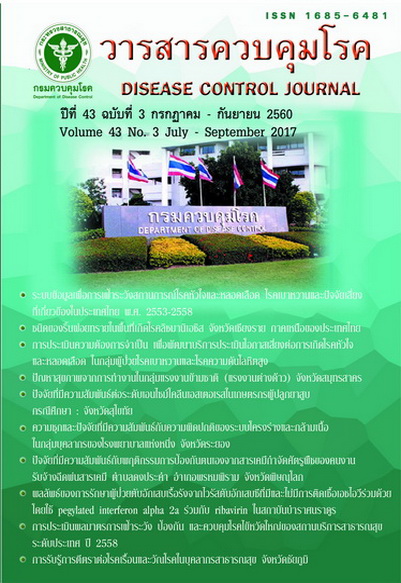Factors related to behaviors on pesticide protection of pesticide spraying workers in Dong Prakham Sub-District, Phrom Phiram District, Phitsanulok Province
DOI:
https://doi.org/10.14456/dcj.2017.17Keywords:
spraying workers, attitude, knowledge, behaviors on pesticide protectionAbstract
The pesticide spraying workers had more health risks form pesticide exposure than farmers. Especially, they worked in double-crop field that cultivate rice three times a year. The study design was cross-sectional descriptive study and the objective of this study was to study factors related to behaviours on pesticide protection of pesticide spraying workers in Drongphakum Sub-district, Phrom Phiram District, Phitsanulok Province. The KAP theory was applied for data were collected by using questionnaire from 30 spraying workers and was analyzed by descriptive statistics and chi-square test. The results found that most spraying workers had the pesticide protection behaviours at a medium level (63.3%). Despite, they had knowledge and attitude about pesticide protection at a high level of 66.7% and 96.7%, respectively. From studying of factors that related for pesticide protection behaviours, the finding showed that personal factors, knowledge and attitude don’t related to behaviours on pesticide protection. However, the health problems such as hypertension and allergy related for the pesticide protection behaviours showed significant at the 95% (p=0.03). From this study results showed that pesticide issues will only improve pesticide protection behaviours due to their behaviours be from habitude for personal protection equipment (PPE) using and they complained about costly, inconvenience, take time and feeling the heat for PPE wearing. Therefore, it is importance for creating awareness of health risks from pesticide exposure because the result found that who had the health problems such as hypertension and allergy, always consult form the doctors, so they had more awareness from pesticides. Moreover, most of them (90.00%) didn’t ever detect pesticides in blood. There¬fore, related organization should to give more knowledge, attitude and practices supporting for less score topics, service for pesticide detection in order to increase awareness of the pesticides harmful effects. May be they will improve the behaviours for pesticide protection.
Downloads
References
2. กันทิมา ลีจันทึก. ไทยนำเข้าสารพิษเกษตรอันดับ 5 ของโลก [อินเทอร์เน็ต]. [สืบค้นเมื่อ 3 ก.ย. 2558]. แหล่งข้อมูล: http://www.thaihealth.or.th/ Content/22316-ไทยนำเข้าสารพิษเกษตรอันดับ %205%20ของโลก%20.html
3. กองระบาดวิทยา กระทรวงสาธารณสุข. สรุปรายงาน การเฝ้าระวังโรค ปี 2547. กรุงเทพมหานคร: องค์กร รับส่งสินค้าและพัสดุภัณฑ์; 2548.
4. Plianbangchang P, Jetiyanon K, Wittaya-areekul S. Pesticide use patterns among small-scale farmers: A case study from Phitsanulok, Thai¬land. Southeast Asian J Trop Med Public Health 2009;40:401-10.
5. Sapbamrer R, Nata S. Health symptoms related to pesticide exposure and agricultural tasks among rice farmers from northern Thailand. Environ Health Prev Med 2014;19:12-20.
6. He F, Wang S, Liu L, Chen S, Zhang Z, Sun J. Clinical manifestations and diagnosis of acute pyrethroid poisoning. Toxicol 1989;63:54-58.
7. Hallenbeck WH, Cunningham-Burns KM. Pesticides and human health. New York: Springer-Verlag; 1985.
8. Repetto R, Baliga SS. The experimental and wildlife evidence. In: Repetto R, Baliga SS, editors. Pesticides and the immune system: the public health risks. Washington, DC: World Resources Institute, National Center for Food and Agricultural Policy; 1996. p. 39-58.
9. Go V, Garey J, Wolff MS, Pogo BGT. Estro¬genic potential of certain pyrethroid compounds in the MCF-7 human breast carcinoma cell line. Environ Health Perspect 1999;107:173-7.
10. กรมควบคุมมลพิษ. รายงานสถานการณ์มลพิษของ ประเทศไทย ปี 2551. กรุงเทพมหานคร: รุ่งศิลป์ การพิมพ์; 2553.
11. สถาบันวิจัยข้าว. มุมการจัดการความรู้ศูนย์วิจัยข้าว พิษณุโลก [อินเทอร์เน็ต]. [สืบค้นเมื่อ 23 มี.ค. 2559]. แหล่งข้อมูล: http://psl.brrd.in.th/km/ index.php?option=com_content&view=arti¬cle-&id=44
12. สำนักงานพัฒนาชุมชนจังหวัดพิษณุโลก. ข้อมูลพื้นฐานด้านการเกษตรจังหวัดพิษณุโลกประจําปี2553 [อินเทอร์เน็ต]. [สืบค้นเมื่อ 3 ก.ย. 2558]. แหล่งข้อมูล: http://chm-thai.onep.go.th/ chm/ data_province/Phitsanulok/doc/สำนักงานเกษตร และสหกรณ์จังหวัด.pdf
13. สำนักโรคจากการประกอบอาชีพและสิ่งแวดล้อม กรมควบคุมโรค กระทรวงสาธารณสุข. โรคและภัย สุขภาพจากสารเคมีกำจัดศัตรูพืช [อินเทอร์เน็ต]. [สืบค้นเมื่อ 12 ธ.ค. 2558]. แหล่งข้อมูล: http:// envocc.ddc.moph.go.th/uploads/situation/situ-year58/4_4_situlation56_03.pdf
14. จีรภา จำศีล. แหล่งข้อมูลปัจจัยที่มีอิทธิพลต่อ พฤติกรรมการป้องกันตนเองจากสารเคมีกำจัด ศัตรูพืชและสัตว์ของเกษตรกรผู้ปลูกสับปะรด ตำบลบ้านเสด็จ อำเภอเมือง จังหวัดลำปาง [วิทยา นิพนธ์ปริญญาศิลปศาสตรมหาบัณฑิต]. เชียงใหม่: มหาวิทยาลัยเชียงใหม่; 2555. 127 หน้า.
15. วีราษฎร์ สุวรรณ. ปัจจัยที่มีความสัมพันธ์ต่อการ ป้องกันตนเองจากการใช้สารเคมีกำจัดศัตรูพืชของ เกษตรกรทำสวนมะลิ ตำบลศิลาอำเภอเมือง จังหวัด ขอนแก่น. วารสารวิจัยสาธารณสุขศาสตร์ มหาวิทยาลัย
ขอนแก่น 2555;6:24-33.
16. สำนักโรคจากการประกอบอาชีพและสิ่งแวดล้อม กรมควบคุมโรค กระทรวงสาธารณสุข. คู่มือสำหรับ เจ้าหน้าที่สาธารณสุข แนวทางการดำเนินงานเกษตรกร ปลอดโรค ผู้บริโภคปลอดภัย สมุนไพรล้างพิษ กายจิตผ่องใส. กรุงเทพมหานคร: ชุมนุมสหกรณ์ การเกษตรแห่งประเทศไทย; 2553.
17. Bloom BS. Human characteristics and school learning. New York: Mcgraw Hill Book; 1976.
18. Best JW. Research in education. 3rd ed. New Jersey: Prentice hall; 1977.
19. สุระชัย ยะเครือ. ปัจจัยที่มีความสัมพันธ์กับ พฤติกรรมการป้องกันอันตรายจากการใช้สารเคมี ทางการเกษตรของเกษตรกรในอำเภอบ่อพลอย จังหวัดกาญจนบุรี [วิทยานิพนธ์ปริญญาวิทยาศาสตร มหาบัณฑิต]. กรุงเทพมหานคร: มหาวิทยาลัย เกษตรศาสตร์; 2550. 137 หน้า.
20. พยนต์ อินมณี. รายงานการวิจัยการศึกษาความรู้ และพฤติกรรมการใช้สารเคมีทางการเกษตรของ เกษตรกรบ้านใหม่ชัยเจริญ ตําบลสถาน อําเภอปัว จังหวัดน่าน. น่าน: สถานีอนามัยตำบลสถาน; 2550.
Downloads
Published
How to Cite
Issue
Section
License
Articles published in the Disease Control Journal are considered as academic work, research or analysis of the personal opinion of the authors, not the opinion of the Thailand Department of Disease Control or editorial team. The authors must be responsible for their articles.






